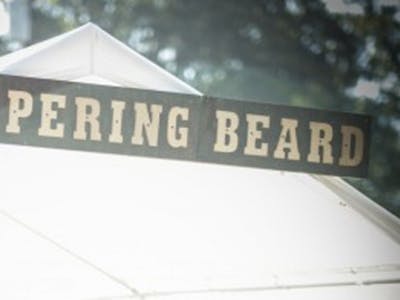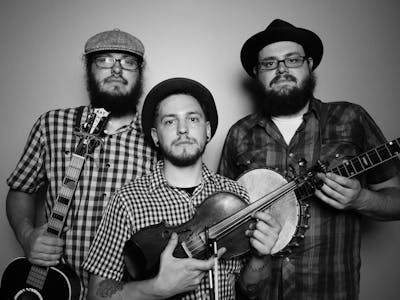If you ever need to take a break from the everyday chaos, tuning everything present out of you mind, the city lights, the honking cars, and the non-stop bustle, then The Tillers are your passport to another portal, back in time. The trio, Mike Oberst, Sean Geil, and Aaron Geil tell their modern-day ancient stories of Cincinnati’s past, reliving and relating their blend of folk, bluegrass, jazz, and punk rock to fans here in Cincy and even branching out all over the nation, U.K., and Ireland, never disappointing their dedicated and increasing fan base. After seven successful years, The Tillers will make their annual appearance at The Whispering Beard Folk Festival. Just in time for the event, I time warped to talk with Mike about how they got their start busking in Clifton, what influences their music, and what to expect at the Beard!
Check out this video of The Tillers at Buckle Up Music Festival!
CB: I grew up in a small farm town in Indiana much like Sean and Aaron, which has greatly influenced my taste and appreciation for folk music. Although you don’t have to be raised in the country, as evident by your origin of Sayler Park, how has your upbringing influenced your music, especially since you had your beginnings in the punk scene?
MO: Where I live isn’t as suburby as some suburbs can get. Sayler Park is an old suburb, but it’s still a city. When I started getting into traditional American roots music, my mind was stuck in the country. I went back to a lot of things I missed from my childhood. My dad’s mom grew up in really rural parts, and I only got a little taste of that. I felt like it really suited me, but I was never living there and only got to visit there for long amounts of time. My mother grew up in upstate New York and my dad grew up in western Indiana, his family raised Angus cattle and my mom’s parents raised sheep and had a huge farm. That is how everyone lived around them. I think it was a little bit of their lives. I would say it was a handful of things as to why I started listening to and ended up writing this sort of music to. Missing that, feeling like I missed out on the call that my grandparents lived in, I felt more akin to than living in the suburbs. Life may be freer out in the country. At the same time, I love city life. The music of the city, underground, some of the music I love. Music was real and raw. That was another thing that it was too.
CB: You got your start busking the streets of Clifton many years ago as apparent from your debut album, Ludlow Street Rag. How did meet and get your start as The Tillers?
MO: Sean and Aaron, at the time were playing with a bluegrass band called the Mt. Pleasant String Band, and I was playing with an Irish folk group called the Blue Rock Boys. Sean ended up coming to a show at the Crow’s Nest when the Blue Rock played there. We didn’t play much on the west side of town; we just played a lot on the north side. That’s where I originally met Sean was at the Crow’s Nest because he was actually living on the west side. The Blue Rock Boys and the Mt. Pleasant String Band, we played a show together on the east side of town at Stanley, and that’s where I first heard Sean play guitar. The style he played in was slap-picking, country blues style was something that when I heard, I immediately was like, “I’ll play with that guy.” Also, when I heard him sing, I was like, “I want to sing with that guy. I like that guy’s voice.” I had in my mind already that I wanted to work on a different group that was more American folk music style and not so much the Irish folk bands. It was already in my mind of trying to figure out who I wanted to play in a band with. The Blue Rock Boys were on hiatus because the lead singer, Pete Wood, was moving to New York City to go to school for journalism, so we were disbanding. In my head, I was like, “Who would be awesome to be in a band with?” Sean was one of them. Jason Soudrette, who was my old buddy, who I played in a punk rock band called Disarm with, and who is now one my best friends. Disarm broke up in 2002, so it had been about three and half years since he and I had played any music together. Reaching out to Jason again, I knew that he had never played the upright bass, but I knew that he could. So, I asked him to, and he didn’t even have an upright bass, but he said he would be in my band. I like Sean as a person, and I loved his playing. I love my good friend Jason as a person, his determination, and his playing. I wanted to be in a band with people that I could be comfortable with, that could make music freely together, and be really laidback about the whole process. Sean is super ambitious. That’s really what we needed because we were so into it, and when the band came out we were balls to the wall, full steam ahead. We wanted to play as many shows as we possibly could anywhere. We weren’t going to pay attention to money. We were just going to go as hard as we could, and so we did. I think it worked.
CB: So many of your songs paint a picture of the things that we Cincinnatians love and relate so strongly to such as Old Westside and There Is A Road (Route 50). What inspires you to write all of your great stories of Cincinnati?
MO: The story of Elizabeth at The Southgate House, when I heard that tale it seemed like “Why isn’t this a song?” Someone needs to do something with this. It’s too good to be a story that might be threatened by someone forgetting it for too long, and it just disappearing. I wrote a song about Route 50 because I grew up driving it with my dad to see our family in western Indiana. I wrote a song about the road because it’s a fantastic road where you can see the whole country, the center of the country at least, the Atlantic, and the Pacific. But at the same time, I partly wrote the song too because the nostalgia of spending so much time on it with my dad and the very simple way to explain it. I like writing songs about things I know about. I always enjoy listening to old Blues songs and hearing about where someone is from. Music used to be more regional. People would write more about what they know, and specifics about location in the world. You just don’t hear about people talking about Cincinnati stuff. It just kind of pops in there. We like where we’re from.
CB: You just released a new video of Willy Dear last month from album Hand on the Plow, another epic story based on a ghost story that haunts the historic Southgate House, created with the help of animation artist, Christopher Heuer. How did video come about?
MO: The video just kind of happened. We are signed to a small DIY record label called Muddy Roots Records. Before Muddy Roots was a record label, they were and still are, a music festival in Cookeville, Tennessee. They often have a Muddy Roots festival in Belgium. Muddy Roots know a really great artist in Germany named Christopher Heuer. He does a lot of artwork for Muddy Roots festival, especially the Belgium one. He heard the song and apparently fell in love with it and decided to animate the video, so we just went along with it. We were really excited to see what was going to happen. I didn’t really believe at first that it would come to fruition because it sounded like too big of a task, but then again, I never met Christopher Heuer. I’m glad it wasn’t too visually similar. I’m glad it was from the imagination of Christopher, this guy that has never been to the U.S. It looks a lot different in my imagination and what I thought, and from talking to so many other people too. Everyone has their own imagery of what was happening in the song. This is a really neat representation of how Christopher thought - a really beautiful thing.
CB: Not that it is any surprise, but you are a fan-favorite at The Whispering Beard Festival. As a returning act, what are you most looking forward to? What should fans expect?
MO: I am exciting about friends that we usually see there. Whispering Beard is a big, huge family. I am really anxious to see the Fairfield Four, and I’m going to try to get J.D. Wilkes to play with us for a song or two. We are trying to work it out so we can have as many people on stage as possible, guest musician wise, but we are trying to figure out how to do some of these songs with folks.
CB: Besides the Whispering Beard Festival, what is your favorite local venue to play?
MO: One of our favorites is the Southgate House Revival. The old one had so much to it, it’s hard to forget it. So much happened to us in that building, and with all the people that were there at that moment in time when the band started, even before the band, when we were going to show to enjoy local music. All of the time spent in that place, we still miss it. Great things are happening in the new Southgate House Revival. Things are starting to come together. It takes a long time the start from scratch with a new music venue and get all of the bugs worked out. I miss the old one, but you have to move on to bigger and better things. It’s one of a kind. There’s nothing else like it.



